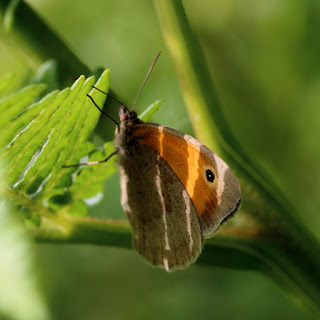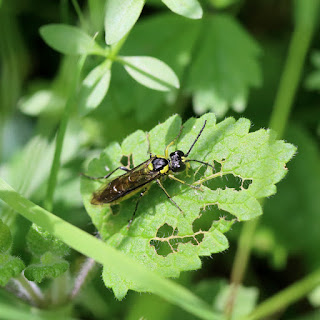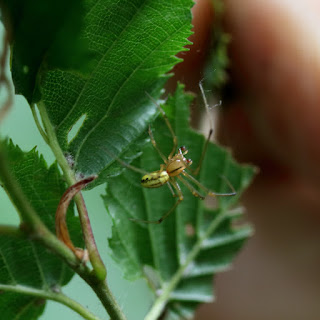You are probably familiar with bee hotels. Many shops and companies sell them and they are basically a selection of holes of various sizes up to about 8mm in diameter, or a bunch of bamboo stems which provide ready made holes. These are to attract solitary bees which use them for 'nesting'. The term nesting is not entirely like the idea of somewhere to raise young and to look after them until they fledge like birds do. In the solitary bee world, they are indeed to raise young, but the adult insect will not stick around to look after the brood. They lay their eggs, protect them as best they can, and then die. Basically most species use a tube-like space of some sort in which to lay their eggs, and many species use bee hotels whether that is their natural sort of hole or not. If you buy or make a bee hotel, and why wouldn't you if you want your apple trees pollinated - you will see that they have been used when the end of the holes are blocked off with mud or some other material.
It is not just the end that is blocked up. The female solitary bee lays an egg at the far end of the tube and then provides the egg with food - in most cases pollen. She then seals that cell and lays another egg, leaves food, and seals off the cell. She will carry on doing that until the tube is full. When the eggs hatch the larva will eat the pollen, turn into a pupa (chrysalis in butterfly terms), and wait for spring when they will emerge as an adult bee to carry on the cycle. There are more than 220 species of solitary bee in the UK and they differ in where they nest, and how they seal up the cells where the eggs are laid. Mining bees dig holes in the ground and use mud, leafcutter bees use leaves to make a tube, and then seal off the cells with leaves, mason bees use holes in mortar and use mud as seals.
Just recently I have come across two species that use fairly unusual egg-storing methods. Firstly, one of the Pett badminton players, Jacqui, showed me photographs of a wool carder bee (
Anthidium manicatum) that had been flying around foxgloves in her garden. We have had this species in our garden for the first time this year. The wool carder bee gets its name because it collects long hairs from plants such as the hairs inside foxglove flowers, or the hairs from the leaves of lamb's ear (
Stachys byzantina), which we have also had in our garden for the first time this year. (Coincidence?! - no.) It uses the hairs to seal off the cells, and will happily use the tubes in a bee hotel.
 |
| Wool-carder bee |
Another species that I came across only recently is the fork-tailed flower bee (
Anthophora furcata). This is the only solitary bee species that digs its hole in dead or rotten wood and I took this picture of it excavating wood from the planks of a footbridge across a ditch near Toot Rock at Pett Level. I'll cross that bridge with care in future, not because of the young bees there, but because both I and at least one solitary bee know how solid that plank is - or isn't!
 |
| Fork-tailed Flower Bee |





































































